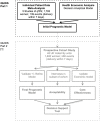Quantitative fibronectin to help decision-making in women with symptoms of preterm labour (QUIDS) part 1: Individual participant data meta-analysis and health economic analysis
- PMID: 29627817
- PMCID: PMC5892771
- DOI: 10.1136/bmjopen-2017-020796
Quantitative fibronectin to help decision-making in women with symptoms of preterm labour (QUIDS) part 1: Individual participant data meta-analysis and health economic analysis
Abstract
Introduction: The aim of the QUIDS study is to develop a decision support tool for the management of women with symptoms and signs of preterm labour, based on a validated prognostic model using quantitative fetal fibronectin (qfFN) concentration, in combination with clinical risk factors.
Methods and analysis: The study will evaluate the Rapid fFN 10Q System (Hologic, Marlborough, Massachusetts) which quantifies fFN in a vaginal swab. In part 1 of the study, we will develop and internally validate a prognostic model using an individual participant data (IPD) meta-analysis of existing studies containing women with symptoms of preterm labour alongside fFN measurements and pregnancy outcome. An economic analysis will be undertaken to assess potential cost-effectiveness of the qfFN prognostic model. The primary endpoint will be the ability of the prognostic model to rule out spontaneous preterm birth within 7 days. Six eligible studies were identified by systematic review of the literature and five agreed to provide their IPD (n=5 studies, 1783 women and 139 events of preterm delivery within 7 days of testing).
Ethics and dissemination: The study is funded by the National Institute of Healthcare Research Health Technology Assessment (HTA 14/32/01). It has been approved by the West of Scotland Research Ethics Committee (16/WS/0068).
Prospero registration number: CRD42015027590.
Version: Protocol version 2, date 1 November 2016.
Keywords: fetal fibronectin; health economics; individual patient data meta-analysis; pregnancy; preterm birth.
© Article author(s) (or their employer(s) unless otherwise stated in the text of the article) 2018. All rights reserved. No commercial use is permitted unless otherwise expressly granted.
Conflict of interest statement
Competing interests: SJS and JEN work at the University of Edinburgh, who received £1000 sponsorship from Hologic to support a meeting (Scientific Symposium Targeting Inflammation to Improve Reproductive Health across the Lifecourse (August 2017) in collaboration with The Society for Reproductive Investigation and MRC Centre for Reproductive Health). AS has in the past (over last 5 years; not in the last 3 years) received funding for expenses related to advisory board and internal staff education from Hologic. MC received sponsorship from Hologic to organise an educational teaching focusing on prediction of preterm birth at the 2017 annual meeting of the British Maternal and Fetal Medicine Society. Hologic, the makers of fFN, provided analysers and technical support for their use to sites participating in the QUIDS prospective cohort study. They have no access to the data, or other involvement in the conduct, analysis, interpretation or decision to publish the results of the study.
Figures
References
-
- Office for National Statistics. ONS gestation-specific infant mortality in England and Wales 2011. 2013. https://www.ons.gov.uk/peoplepopulationandcommunity/healthandsocialcare/... (accessed 23 Nov 2017).
-
- Information Services Division. “Births in scottish hospitals 2012”. Edinburgh national services Scotland. 2013. http://www.isdscotland.org/Health-Topics/Maternity-and-Births/Publicatio... (accessed 23 Nov 2017).
Publication types
MeSH terms
Substances
Grants and funding
LinkOut - more resources
Full Text Sources
Other Literature Sources
Medical

